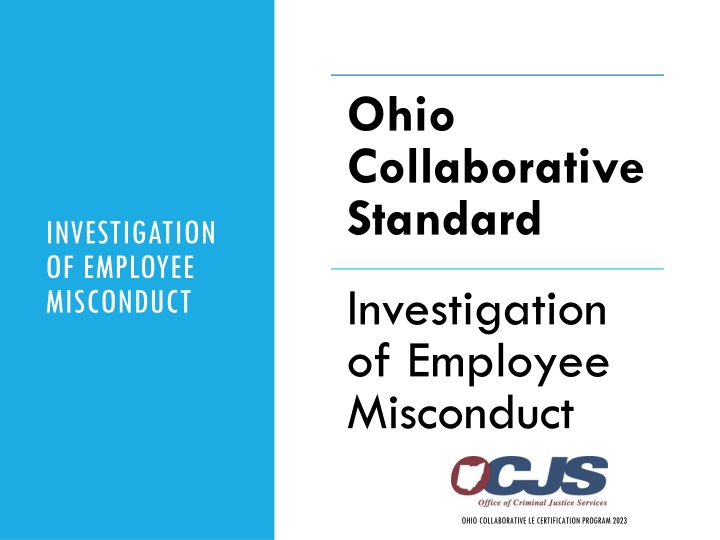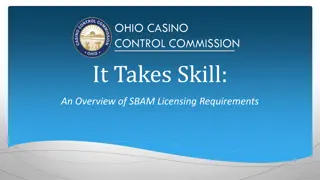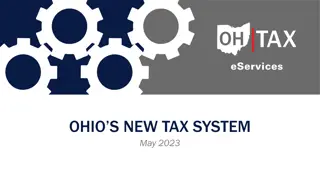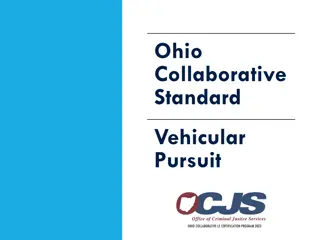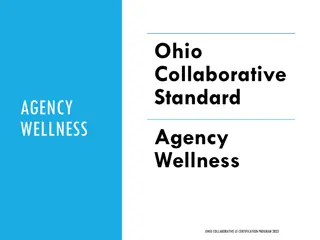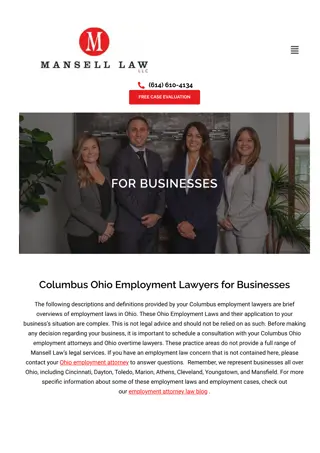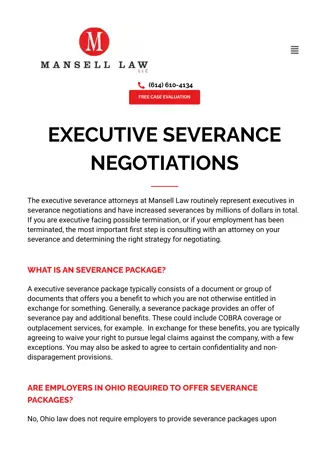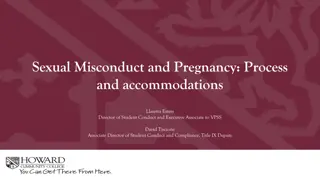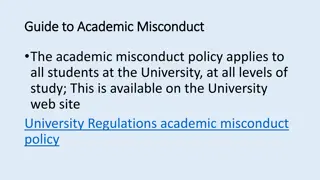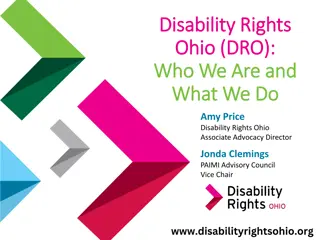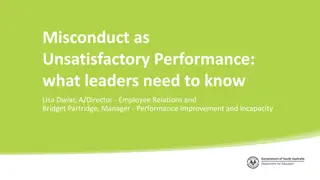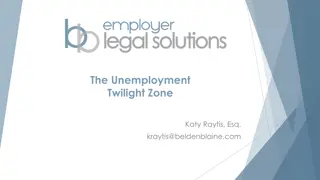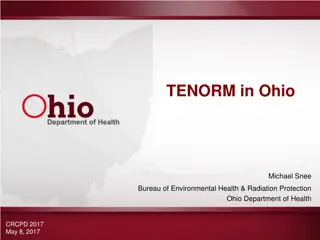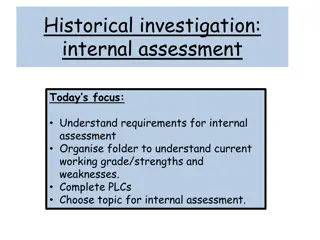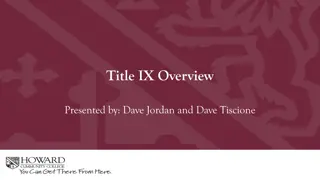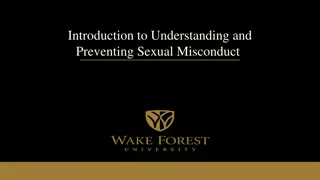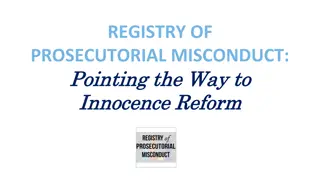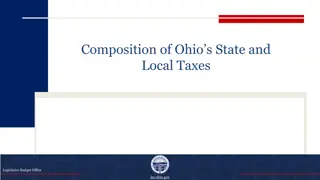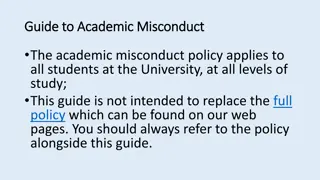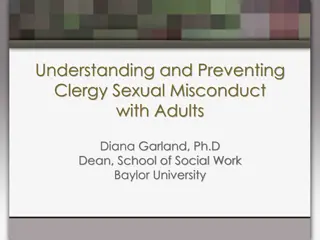Ohio Collaborative Standard: Investigation of Employee Misconduct
Ohio Collaborative Standard focuses on the investigation of employee misconduct in law enforcement agencies, emphasizing the importance of procedural justice, public respect, and comprehensive investigation processes. It outlines the purpose, learning objectives, and the establishment of written policies for handling complaints. The standard aims to enhance transparency, accountability, and community trust.
Download Presentation

Please find below an Image/Link to download the presentation.
The content on the website is provided AS IS for your information and personal use only. It may not be sold, licensed, or shared on other websites without obtaining consent from the author.If you encounter any issues during the download, it is possible that the publisher has removed the file from their server.
You are allowed to download the files provided on this website for personal or commercial use, subject to the condition that they are used lawfully. All files are the property of their respective owners.
The content on the website is provided AS IS for your information and personal use only. It may not be sold, licensed, or shared on other websites without obtaining consent from the author.
E N D
Presentation Transcript
Ohio Collaborative Standard INVESTIGATION OF EMPLOYEE MISCONDUCT Investigation of Employee Misconduct OHIO COLLABORATIVE LE CERTIFICATION PROGRAM 2023
Learning Objectives Investigation of Employee Misconduct: Purpose Standard LEARNING OBJECTIVES Commentary Model policy Compliance
The ability of the police to perform their duties is dependent upon public approval of police existence, actions, behavior and the ability of the police to secure and maintain public respect. INVESTIGATION OF EMPLOYEE MISCONDUCT Sir Robert Peel (1829)
21st Century Policing INVESTIGATION OF EMPLOYEE MISCONDUCT 1.4.2 Action Item: Law enforcement agency leadership should examine opportunities to incorporate procedural justice into the internal discipline process, placing additional importance on values adherence rather than adherence to rules. Union leadership should be partners in this process.
In 2016, The Ohio Collaborative Community- Police Advisory Board adopted the State of Ohio Standard for Investigation of Employee Misconduct. INVESTIGATION OF EMPLOYEE MISCONDUCT
Purpose Law enforcement agencies, and the public at large, will benefit from the establishment, enhancement and the promotion of a genuine and comprehensive employee misconduct investigation process, to include both administrative and citizen complaints. INVESTIGATION OF EMPLOYEE MISCONDUCT
Standard Law enforcement agencies shall establish a written policy which outlines the process for accepting, processing and investigating complaints concerning allegations of employee misconduct. The policy, at a minimum, shall address the following: INVESTIGATION OF EMPLOYEE MISCONDUCT Describe the formal complaint process, outlining how and where to file a complaint; Outline the procedures for accepting, processing and investigating the complaint; Define timelines for the resolution of complaints; Include safeguards to protect the legal and contractual rights of the employees during internal investigations; and Ensure that procedures to register complaints and/or commendations are made available to the public through social media or the agency s community relations programs.
Standard Commentary continued It may prove beneficial for law enforcement agencies to reach out to community members in an effort to publicize, promote and develop processes that are mutually beneficial to all. INVESTIGATION OF EMPLOYEE MISCONDUCT
Standard Commentary A well-constructed complaint process is an integral tool in community-police relations. There is a significant impact when a community knows and understands its concerns can be legitimately addressed in a proper setting. Further, officers can be better served when they can refer aggrieved individuals to a trusted process. Neither officers nor community members benefit from attempts to have concerns addressed and redressed during a traffic stop or in the midst of an incident. INVESTIGATION OF EMPLOYEE MISCONDUCT
INVESTIGATION OF EMPLOYEE MISCONDUCT Investigation of Employee Misconduct Model Policy Purpose The purpose is to establish general procedures, in addition to those provided in (Police/Sheriff s office) policies, written directives, Ohio Revised Code, and recognized collective bargaining agreements, for reviewing citizen complaints, conducting internal affairs investigations, and initiating corrective and/or disciplinary actions against agency personnel.
INVESTIGATION OF EMPLOYEE MISCONDUCT Model Policy Supervisor s Responsibility Nothing in this policy is meant to take away from a supervisor the responsibility of correcting, admonishing, or reprimanding subordinate personnel whenever it is warranted. Final disciplinary authority and responsibility rests with the CEO. Except for informal counseling, oral reprimands, and emergency administrative leaves, all agency discipline must be approved beforehand by the CEO.
INVESTIGATION OF EMPLOYEE MISCONDUCT Model Policy Complaint Investigation It is the policy of this agency that all allegations of employee misconduct be appropriately investigated and promptly adjudicated. All reports or accusations made against employees, from all sources, shall be completely investigated in order to ensure the integrity of the agency and its employees. Anonymous complaints can be difficult to investigate; however, the agency will carefully review each complaint for validation before disregarding it for lack of a credible complainant.
INVESTIGATION OF EMPLOYEE MISCONDUCT Model Policy Complaint Investigation continued The agency has the responsibility to protect the rights of all persons within its jurisdiction. This includes protecting employees from false allegations. Complainants should be aware of these ORC sections: ORC 2917.32 (A)(3) No person shall report to any law enforcement agency an alleged offense or other incident within its concern, knowing that such offense did not occur.
INVESTIGATION OF EMPLOYEE MISCONDUCT Model Policy Complaint Investigation continued ORC 2921.13 (A) No person shall knowingly make a false statement, or knowingly swear or affirm the truth of a false statement previously made when any of the following apply: The statement is made with purpose to mislead a public official in performing his function. ORC 2921.15 (B) No person shall knowingly file a complaint against a peace officer that alleges that the peace officer engaged in misconduct in the performance of the officer s duties if the person knows that the allegation is false. *(These crimes are misdemeanors of the first degree punishable upon conviction by a fine not more than $1,000 and/or imprisonment not more than 6 months).
Model Policy Records Maintenance and Security Every internal affairs or citizen complaint investigation report shall be assigned a case reference number. The numbering system will be sequential in nature and will start over each January. Example, the first case of 2018 would be numbered 18-01; the next case 18-02, etc. The original case file will be maintained by the CEO, or designee, until the case is closed. At the conclusion of the case, the file will be stored in a locked file cabinet under the control of the CEO, or designee. Only the CEO, or designee, will have access. The case file will remain in the file cabinet until disposed of under the rules of the Records Retention Schedule. INVESTIGATION OF EMPLOYEE MISCONDUCT
Model Policy Direct Accessibility to the Chief of Police or Sheriff The CEO, or designee, is responsible for the Internal Affairs function. This function reports directly to the CEO. Generally, the member s supervisor will be assigned, through the chain of command, to conduct the investigation. The CEO may determine it necessary to assign another individual to serve as the IA investigator due to extenuating circumstances. In such cases, the investigator may be directed by the CEO to report directly to them regarding matters concerning the IA investigation. Any and all personnel have the ability to report directly to the CEO when investigating an internal affairs case. INVESTIGATION OF EMPLOYEE MISCONDUCT
INVESTIGATION OF EMPLOYEE MISCONDUCT Model Policy Complaint Registering Procedures The agency makes information available to the public on procedures to be followed in registering complaints against the agency and/or its employees. The complaint process is outlined on the agency website and available in pamphlet form. Complaints shall be accepted in person, by telephone, email or agency complaint form. Commendations shall be made available to the public in the same manner. Annual Summaries-Public Availability The CEO or designee will compile an annual statistical summary of all internal investigations that will be made available to the public and all agency employees.
Model Policy Complaint Types Generally, there are two types of complaints, criminal misconduct or non-criminal misconduct. Supervisors receiving a complaint regarding officer or civilian employee behavior shall review the complaint and determine which of the following categories it falls into. If, after preliminary review, the supervisor determines that the complaint does not fit either category, he/she should document the complaint in their supervisor notes. A complaint against a member which alleges criminal misconduct is considered to be a criminal complaint and is subject to the formal internal affairs function. Criminal misconduct is defined as any action in violation of the Ohio Revised Code. INVESTIGATION OF EMPLOYEE MISCONDUCT
Model Policy Complaint Types continued Non-criminal misconduct is defined as behavior which is either unethical or immoral, and has the potential for reflecting negatively upon the reputation and image of the agency, but does not constitute a violation of the Ohio Revised Code. A complaint which alleges such behavior is considered a non-criminal misconduct complaint. INVESTIGATION OF EMPLOYEE MISCONDUCT No employee will be intentionally misled into the belief the investigation is of a non-criminal nature while, in fact, it is a criminal misconduct complaint. An investigation of that may become criminal in nature is considered formal, is subject to the formal internal affairs function and the affected employee is advised of his/her Garrity rights (an employee being questioned as part of an official internal investigation, must answer all questions or face agency disciplinary action, and that no statements can be used against him/her in any subsequent criminal proceeding) and Piper rights (any employee under investigation by internal affairs, shall be permitted to have an attorney present during questioning).
Model Policy Complaint Types continued Non-criminal complaints will be taken by the on-duty supervisor. An informal inquiry will be conducted which may result in no further investigation or in a request for a formal IA investigation. In informal inquiries, the accused employee will be informed of the complaint. Investigations should be conducted by the employee s supervisor. The following types are examples: INVESTIGATION OF EMPLOYEE MISCONDUCT Non-criminal complaints, non-violence complaints and policy violations The results of all informal inquiries will be in writing and documented in supervisory notes with the final disposition noted. The supervisor should advise their superior officer of the inquiry.
INVESTIGATION OF EMPLOYEE MISCONDUCT Model Policy Notification of the CEO Whenever the incident allegedly committed by the employee is a criminal matter, and the evidence is such that if the crime had been committed by a citizen would have generated an arrest, the CEO shall be advised of the circumstances and render a decision as to whether the employee should be arrested; or criminal action should be delayed pending further investigation. The CEO shall be informed as soon as practical of investigations of a lesser nature. Investigation Time Limits All complaints against the agency, or employees, shall be completely investigated within sixty days from the date of the filing of the complaint. The CEO may, on a case-by-case basis, grant an extension to this time limit, at his/her discretion based on extenuating circumstances.
INVESTIGATION OF EMPLOYEE MISCONDUCT Model Policy Collective Bargaining Nothing in this policy shall interfere with rights or procedures outlined for officers covered by the collective bargaining agreement between the employer and the union. Informing Complainants When an individual wishes to make a complaint, the on-duty supervisor will review the complaint process with them and answer any questions that they may have. This process is outlined on the agency website: _____________ Once the investigation is completed the complainant(s) shall be advised of the findings and whether or not any corrective and/or disciplinary action resulted.
Model Policy Statement of Allegations/Rights When employees are notified that they have become the subject of an internal affairs investigation, the agency shall issue the employee a written statement of the allegation(s) and the employee s rights and responsibilities relative to the investigation. Cooperation and Truthfulness INVESTIGATION OF EMPLOYEE MISCONDUCT Agency personnel shall fully cooperate during internal affairs and citizen complaint investigations. All personnel are required to truthfully answer questions, render relevant statements, material and evidence in connection with such investigations. Personnel who fail to cooperate, or who are not truthful, shall be subject to disciplinary action up to and including termination from the agency. Dissemination of Findings Agency personnel who are the subject of an internal affairs or citizen complaint investigation shall be informed in writing of the findings and, when appropriate, any corrective and/or disciplinary action. The complainant(s) of any complaint shall be advised of the findings and whether or not any action resulted. Appeal Employees have the right to appeal per policy and collective bargaining agreements.
INVESTIGATION OF EMPLOYEE MISCONDUCT Model Policy Submission to Tests During an internal affairs investigation, specific questions may arise that can be answered through specific testing or procedures. The following guidelines shall be used in such cases: An employee may be required to submit to a medical or laboratory exam, at agency expense, when the exam is specifically directed and narrowly related to a particular internal affairs investigation being conducted by the agency. An example is when there are indications that agency personnel is physically or mentally impaired due to the consumption of alcohol and/or drug abuse. The employee shall submit to the appropriate test. An employee may also be required to be photographed with the photo used in an IA investigation. An employee may also be required to submit to a line-up. Further, financial disclosure statements may be required. A polygraph exam may be used as an investigative aid as per the provisions provided by the labor agreement. No employee who is subject to criminal prosecution shall be ordered or coerced to waive any right granted by law. If there is the potential for criminal prosecution, officers who are ordered to provide statements during an IA investigation are protected under the Garrity Rule.
Relieved from Duty Upon notification of an incident of alleged misconduct, or personal knowledge of misconduct by agency personnel, a command officer or supervisor may immediately place the person on emergency administrative leave, and direct him/her to report to the CEO before returning to duty. The supervisor may order this emergency administrative leave when the action of the person is, for example, grossly immoral, indecent, brutal, involved the physical mistreatment of another person; or when the accused personnel is intoxicated, refused to obey a lawful order of a superior officer or refused to comply with law(s) and/or agency policy; or is otherwise unfit for duty. When an accused is placed on emergency administrative leave, the supervisor shall, as soon as practical, notify the CEO. Corrective Action and Involuntary Termination authorizes administrative leave in circumstances when the health or safety of any staff member or any person or property entrusted to the staff member s care could be adversely affected, or during an administrative investigation. INVESTIGATION OF EMPLOYEE MISCONDUCT
INVESTIGATION OF EMPLOYEE MISCONDUCT Model Policy Conclusion of Fact All investigations into allegations of misconduct shall result in a Conclusion of Fact which will be designated as follows: Unfounded: The investigation conclusively proved the act(s) complained of did not occur. This finding also applies when the individual personnel was not involved in the act(s) which may occurred. Exonerated: The act(s) which provided the basis for the complaint or allegation occurred; however, investigation revealed it was justified, lawful and proper. Sustained: The investigation disclosed sufficient evidence to clearly prove the allegation(s) made in the complaint. Not sustained: Insufficient evidence to either prove or disprove allegation(s).
Model Policy Corrective and/or Disciplinary Action When a finding of Sustained is included in a final summary report of investigation, the CEO will determine whether immediate corrective and/or disciplinary action will be initiated in conformity with the findings in the report. When disciplinary action is indicated by the findings, one or more of the following actions may be taken by the CEO, or the appointing authority, subject to the provisions of agency policies, and recognized collective bargaining agreements: INVESTIGATION OF EMPLOYEE MISCONDUCT Informal counseling Oral reprimand Written reprimand Denial or delay of promotion Suspension Demotion Termination Corrective Action and Involuntary Termination
Compliance Examples: Proof of timelines being met (redacted communications) bullet D INVESTIGATION OF EMPLOYEE MISCONDUCT Assessors verify the following is made available to the public by web posting or some other form of public notice bullets B & C The formal complaint/commendation process (including where and how to file a complaint/commendation including time frames) Employee rights are being safeguarded by union contract or policy bullet E
INVESTIGATION OF EMPLOYEE MISCONDUCT Recommendation: The standard advises that the public will have access to register complaints but also commendations for employees. Agencies should ensure the public may send in commendations on the agency website, etc.
